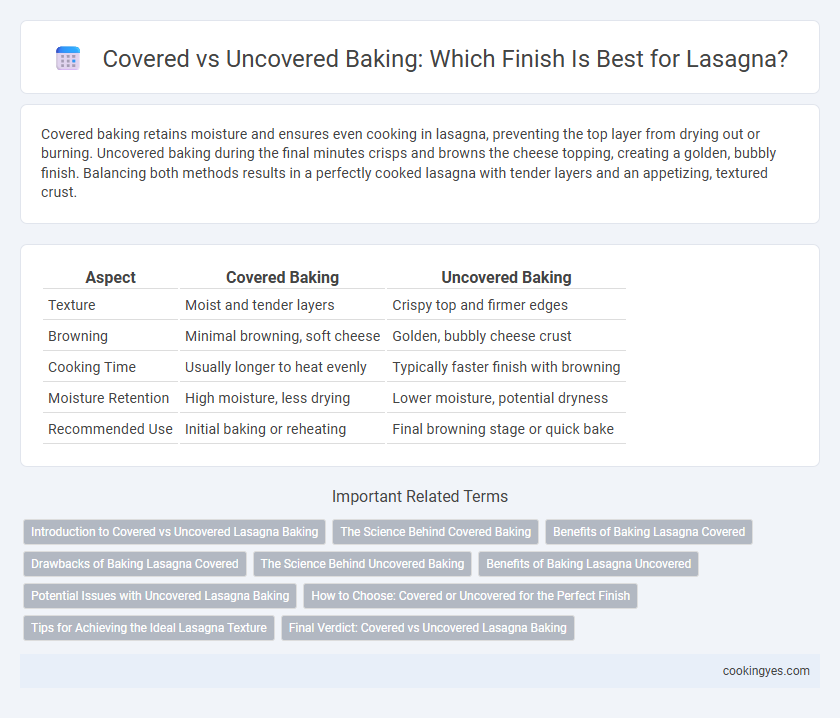Covered baking retains moisture and ensures even cooking in lasagna, preventing the top layer from drying out or burning. Uncovered baking during the final minutes crisps and browns the cheese topping, creating a golden, bubbly finish. Balancing both methods results in a perfectly cooked lasagna with tender layers and an appetizing, textured crust.
Table of Comparison
| Aspect | Covered Baking | Uncovered Baking |
|---|---|---|
| Texture | Moist and tender layers | Crispy top and firmer edges |
| Browning | Minimal browning, soft cheese | Golden, bubbly cheese crust |
| Cooking Time | Usually longer to heat evenly | Typically faster finish with browning |
| Moisture Retention | High moisture, less drying | Lower moisture, potential dryness |
| Recommended Use | Initial baking or reheating | Final browning stage or quick bake |
Introduction to Covered vs Uncovered Lasagna Baking
Baking lasagna covered traps steam and moisture, promoting even cooking and tender pasta layers, while uncovered baking allows the top to brown and crisp, developing a golden, bubbly cheese crust. Covered baking prevents the sauce from drying out, maintaining a moist texture essential for creamy consistency. Uncovered baking is ideal for achieving a caramelized, textured finish that enhances flavor and presentation.
The Science Behind Covered Baking
Covered baking of lasagna traps steam, maintaining moisture and allowing flavors to meld while preventing excessive browning of the top layer. The trapped steam increases internal pressure, accelerating heat transfer and evenly cooking the pasta and filling without drying out the edges. This method preserves the desired soft texture and prevents the cheese from becoming overly crisp or burnt, ensuring a balanced finish.
Benefits of Baking Lasagna Covered
Baking lasagna covered helps retain moisture, ensuring the noodles and cheese remain tender and prevent drying out. The foil or lid traps steam, which promotes even cooking and rich flavors by allowing the sauce to meld thoroughly with the pasta layers. Covered baking also minimizes browning of the top layer, providing a soft, cohesive texture before the final uncovered baking for a golden finish.
Drawbacks of Baking Lasagna Covered
Baking lasagna covered can trap steam, leading to a soggy texture and preventing the top layer from developing a browned, crisp finish. Excess moisture accumulation under the foil often results in a less flavorful dish with a dull appearance. Without proper evaporation, the cheese topping may not caramelize properly, diminishing the lasagna's overall appeal.
The Science Behind Uncovered Baking
Uncovered baking allows moisture to evaporate from the lasagna surface, resulting in a caramelized, golden-brown crust that enhances flavor through Maillard reaction and gentle caramelization. This process promotes browning and a firmer top layer by exposing the pasta and cheese directly to radiant heat. Retaining the moisture with a cover inhibits these chemical reactions, often leading to a softer, less textured finish.
Benefits of Baking Lasagna Uncovered
Baking lasagna uncovered allows the top layer of cheese to develop a golden, crispy texture that enhances both flavor and presentation. It facilitates moisture evaporation, preventing a soggy or watery dish while concentrating the rich tomato and bechamel flavors. This method also helps achieve a perfectly browned crust, contributing to the authentic texture and taste characteristic of traditional Italian lasagna recipes.
Potential Issues with Uncovered Lasagna Baking
Baking lasagna uncovered can lead to uneven cooking and a dry top layer, especially if the sauce is insufficiently moist. The exposed surface is prone to burning or over-browning before the interior is fully heated, compromising texture and flavor balance. Using a cover helps retain moisture, ensuring a tender, cohesive dish with evenly melted cheese and thoroughly cooked pasta layers.
How to Choose: Covered or Uncovered for the Perfect Finish
Choosing covered baking for lasagna helps retain moisture, preventing the noodles from drying out while allowing flavors to meld, especially during initial cooking stages. Uncovered baking promotes browning and a crispy cheese topping, ideal for the final 15-20 minutes to achieve a golden, textured finish. For the perfect lasagna, start covered to cook evenly, then finish uncovered to enhance texture and visual appeal.
Tips for Achieving the Ideal Lasagna Texture
Baking lasagna covered with foil helps retain moisture, preventing the noodles from drying out and ensuring a tender texture. Removing the cover during the last 15-20 minutes allows the cheese to brown and the top to crisp, creating a desirable contrast. For the ideal lasagna texture, start covered to cook evenly, then finish uncovered to achieve a golden, bubbly crust.
Final Verdict: Covered vs Uncovered Lasagna Baking
Covered baking of lasagna retains moisture and ensures even cooking, resulting in a tender, well-blended texture. Uncovered baking promotes browning and crisping on the top layer, creating a desirable golden crust. For the final verdict, covering lasagna during most of the baking time and uncovering it for the last 10-15 minutes offers the perfect balance between moistness and a crispy finish.
Covered baking vs Uncovered baking for finish Infographic

 cookingyes.com
cookingyes.com